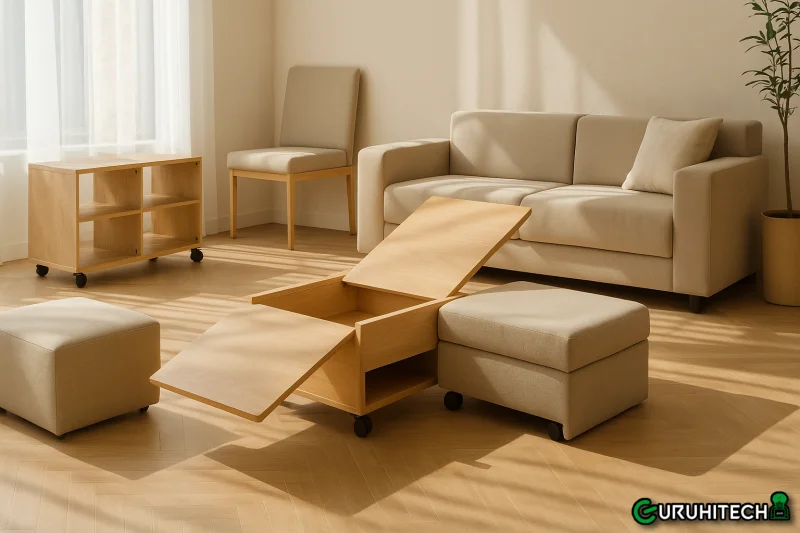Furniture for Fluid Lifestyles: Designing for Flexibility, Movement, and Change

Today’s homes aren’t static—they evolve with us. They shift from morning to night, from solo workspaces to dinner-party settings, from quiet nooks to kid-friendly zones. In a world where lifestyles are less rigid, the furniture we choose must keep pace.
Gone are the days when furniture simply filled a room. Now, it defines how we live, work, and relax within a space that’s constantly in motion.
If your life has multiple roles—remote work, hosting friends, raising a family, squeezing in downtime—your furniture should adapt without compromising style or comfort. Here’s how to design for a life that doesn’t stand still.
Think Modular, Not Monumental
Large, immovable pieces might have once signaled permanence, but today they can feel like anchors in the wrong way. Instead, modular furniture allows for reconfiguration as life shifts:
- Sectionals that separate into smaller units
- Ottomans that work as seating or tables
- Stackable or nesting tables that adapt to occasion
These pieces offer the flexibility to redesign without buying new. Whether you’re moving apartments or just rearranging for a new routine, modular design empowers you to evolve your space on your terms.
Storage That Disguises Itself
One of the biggest challenges in fluid living is clutter control. As rooms change function, so does the accumulation of “stuff.” Smart storage built into furniture can solve this:
- Beds with drawers beneath the frame
- Coffee tables with hidden compartments
- Benches that lift to reveal space inside
These hidden helpers allow you to switch contexts quickly—put away toys, clear work materials, or declutter surfaces in seconds. It’s the behind-the-scenes support system every flexible home needs.
Multi-Zone Living Rooms
Living rooms are no longer single-purpose. Today’s designs often incorporate three or more zones:
- A media corner
- A reading chair
- A flexible table for work or crafts
Instead of choosing furniture that assumes a singular use, think spatially. Lightweight pieces can move around easily. Rugs help define separate areas within one open space. Tall bookshelves or open-backed partitions help divide the room without closing it off.
A quick visit to a modern furniture store often reveals surprising pieces designed for these multi-zone lifestyles—furnishings that look refined but are built to move and adapt.
The Rise of Mobile Furniture
Wheels aren’t just for office chairs anymore. Carts, portable islands, and rolling storage have become integral to dynamic spaces.
A few ideas:
- A bar cart that becomes a coffee station by morning
- A rolling table that goes from dining to crafting
- Compact carts for bathroom or kitchen overflow
These mobile pieces offer freedom—not only to redesign the space, but to enjoy it differently from day to day.
Expandable and Collapsible Options
Fold-out desks, drop-leaf dining tables, and extendable consoles are perfect examples of design that supports fluctuating needs.
Especially in apartments or smaller homes, having furniture that grows (or shrinks) based on context can transform your living experience. A desk can disappear behind a panel. A wall-mounted table can open for dinner and fold back when not in use.
It’s not magic—it’s just good design that listens to your needs.
Rethink the Traditional “Set”
Buying a matching furniture set used to be a one-size-fits-all approach. Now, curated collections of mismatched-yet-harmonized pieces are on the rise. Why? Because they allow for more personal expression—and more adaptability.
Mix and match chairs, tables, and lighting to allow each piece to serve multiple roles. This also ensures that when your lifestyle shifts, your furniture doesn’t feel trapped in one aesthetic box.
Design with Transition in Mind
People’s needs evolve:
- Singles become couples
- Apartments become nurseries
- Spare rooms turn into offices or guest suites
Designing with change in mind isn’t about future-proofing—it’s about staying flexible now. Choose pieces that aren’t so hyper-specific that they lock you in.
An armless slipper chair might start in the bedroom and end up in a living room corner. A small cabinet could live in the kitchen, then transition to a bathroom or hallway.
Fluid homes value versatility above permanence.
Personal Comfort Still Matters
Just because a piece is multifunctional doesn’t mean it should sacrifice comfort. If a sofa doubles as a guest bed, it should still invite everyday lounging. If a desk folds away, it still needs to offer ergonomic value when it’s in use.
Comfort and flexibility aren’t mutually exclusive—they enhance one another when selected intentionally.
This is where brands like What’s New Furniture help bridge the gap between utility and elegance, offering pieces that adjust to your rhythm while still supporting your sense of home.
Final Thought: Design That Moves With You
The best furniture doesn’t just fit your space—it fits your life. It adapts when you need change, supports when you need consistency, and steps back when you need space.
If your days don’t follow a script, your furniture shouldn’t either.
Instead, think of your home as a responsive ecosystem—one that allows you to live freely, rearrange often, and welcome each chapter without redesigning the whole book.
Ti potrebbe interessare:
Segui guruhitech su:
- Google News: bit.ly/gurugooglenews
- Telegram: t.me/guruhitech
- X (Twitter): x.com/guruhitech1
- Bluesky: bsky.app/profile/guruhitech.bsky.social
- GETTR: gettr.com/user/guruhitech
- Rumble: rumble.com/user/guruhitech
- VKontakte: vk.com/guruhitech
- MeWe: mewe.com/i/guruhitech
- Skype: live:.cid.d4cf3836b772da8a
- WhatsApp: bit.ly/whatsappguruhitech
Esprimi il tuo parere!
Che ne pensi di questa notizia? Lascia un commento nell’apposita sezione che trovi più in basso e se ti va, iscriviti alla newsletter.
Per qualsiasi domanda, informazione o assistenza nel mondo della tecnologia, puoi inviare una email all’indirizzo [email protected].
Scopri di più da GuruHiTech
Abbonati per ricevere gli ultimi articoli inviati alla tua e-mail.
